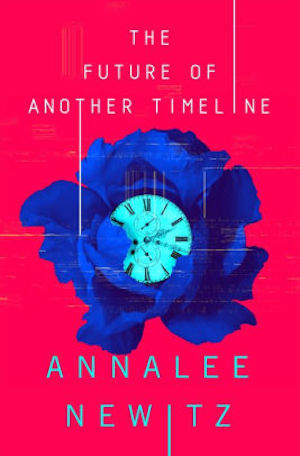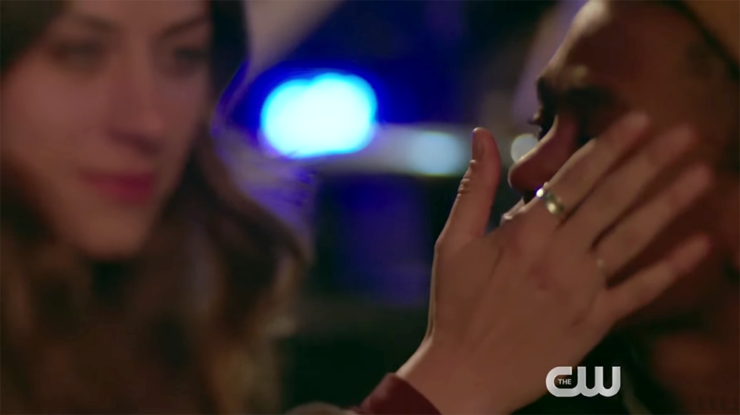The blind woman’s hands graze the young man’s face after he urges her to do so. He eggs her on, saying she needs to feel his beauty. To him, it’s the only way that she’ll know what he looks like. Perhaps to an abled audience, this makes sense.
A scene later, and the blind woman finds a corpse in an alley. She feels the corpse’s face, and knows without a shred of doubt that it is her friend, whose face she just touched at the beginning of the episode.
…Right.
I want you to try something.
Feel your own face—or if you’ve got someone who is willing to let you put your grubby paws all over their face, do that.
Close your eyes.
What do you feel? Do you feel every pore? Do you think your fingers really could tell the difference between the slope of your nose, and the slope of someone else’s? The curve of a cheekbone—will your memory remember the difference between one and the other?
Would you trust your ability to feel the difference between a corpse, skin that has become hardened in the moments after death, and identify it as the same face that was live, skin warm and pliant to your fingertips?
I’m blind, and I can’t.
I’m willing to bet that you can’t either.
I don’t know what the obsession is with the face-touching trope, but The CW’s show In The Dark leans into it, using it as a plot point in multiple episodes.
It is one of the many ways in which the show—which centers on Murphy Mason, the young blind woman who stumbles across her friend’s corpse in the first episode—fails to accurately depict blindness, specifically along the vector of blind physicality.
The physicality of blindness is a failure of many characterizations in film, however—In the Dark just happens to be the most recent, most egregious example.
Face touching, while an obvious example, is not the only one. Murphy’s No Light Perception blindness also falls into the archetype of there only being one kind of blindness, and of course, being played by a sighted actress doesn’t help with the realism. But the blind physicality presented here isn’t limited to touching a face…
During the spring of 2019 I became a guide dog handler. Murphy of In the Dark is also a guide dog handler. In fact, her parents opened a guide dog school so that they could help her.
Leaving aside the fact that guide dog schools are incredibly complex organizations, serving hundreds of guide dog teams, and the various inaccuracies in the depiction of the running of a dog school that I could see… Let’s talk about Murphy’s actual dog handling skills.
In the first place, we don’t know a whole lot about them—because the show chooses to only have Murphy bring her guide with her for select scenes: scenes where it is either dramatic or funny to have the dog on the screen. We frequently see Murphy using a white cane instead of bringing the dog along.
It is hard for me to think of times when I am without a dog. While I’m writing this essay, there is a black lab at my feet. When I am at a grocery store, there is a guide dog leading the way, when I am in a public bathroom—you guessed it, there’s a dog.
So the fact that Murphy at one point jokes about her dog being a stalker… yes, there are certainly feelings of never being physically alone, but as a dog handler I’d never ascribe that as a negative trait.
I am never alone. I am always accompanied by someone who can keep me safe. It is a great privilege to have a dog friend who is willing to stay by my side.
But it isn’t just about the fact that she rejects her partner in crime (investigation). It’s that the bond between dog and human is an absolutely vital part of the guide dog handling process. And there doesn’t seem to be any evidence of this bond in the world of In The Dark.
This undervalues the deep bond between dog and human that has to develop in order to make a guide partnership work. Yes, my dog goes with me everywhere. The few times that I leave him at home—typically to do something like go horseback riding or to get a massage—he stares at me as I leave. And I feel vaguely naked. There’s something missing when I leave the house without my dog.
The dog is not a sometimes adaptive device. Yes, there are times when he is not convenient, yes there are times when he cannot go with me. But those times are rare; they are very, very rare.
Yet Murphy leaves her dog all the time. She doesn’t value their relationship.
Buy the Book


The Future of Another Timeline
When the dog is on screen, Murphy is constantly doing things like flinging a hand out in front of her to find a counter edge. I don’t read any trust in her physicality with the dog. The dog would bring her to the counter. The dog would always be there to support her.
But also, Murphy is a bad handler because she engages in bad behavior in public.
In one scene, Murphy is in a pizza shop, investigating her friend’s death. She picks the pepperoni off her pizza and feeds it to her adorable golden retriever guide (who is sitting up in a restaurant instead of lying underneath the table, safely out of the way). There’s so much wrong with this scenario, but honestly the biggest issue is that I’d never feed my dog anything off my plate in public—because that’s how you get a bad rep. That’s how you end up being kicked out of restaurants, being accused of not having a real guide. That’s behavior you’re told never to engage in, as a dog handler.
I get it: the writers wanted to write a Bad Blind Girl. But you know what? We haven’t had a good one yet.
Shows like In the Dark that show guide dog handlers participating in bad behavior in public don’t help with awareness or make it any easier for me to go places with my dog. They mean that I will be asked, over and over again, for my dog’s paperwork. That I will, in some places, have to fill out paperwork to be polite.
Characters like Murphy don’t scratch the itch of blind representation because they don’t actually represent me.
The failure of In the Dark is that at its core, In the Dark is using blindness as a set dressing to tell a story. It relies on tropes to develop a blindness narrative without ever really acknowledging what it is like to be blind.
Ultimately, that’s why so many blind people find the show to be a betrayal: because we don’t often get stories about blind people that aren’t about blindness.
If Murphy were a character whose blindness actually made sense, who used her adaptive devices well—if the guide dog school weren’t badly described set dressing, if her blindness weren’t so often a joke or a plot device—then I could love Murphy the Bad Blind Girl. Because we do need characters like her.
We do need blind people who have casual sex on TV. We need blind people who have pregnancy scares, who make bad decisions, who aren’t perfect.
But we also need them to be blind. We need them to still use their adaptive devices realistically.
We need more.
We need them to not touch faces… because dear god, why?

Elsa Sjunneson-Henry is a gimlet made from feminism and snark. She’s a deafblind speculative fiction author, and she writes disability focused nonfiction as well. Her work has appeared in Uncanny, Fireside, Tor.com, CNN, and The Boston Globe, and she is a 2019 Hugo Award finalist for Best Fan Writer, as well as a Best Semiprozine Hugo finalist for her work as an editor on Fireside Magazine and Uncanny Magazine’s Disabled People Destroy Science Fiction Special Issue. She writes from a dragon lair in NJ, and can be found on the web @snarkbat and snarkbat.com










